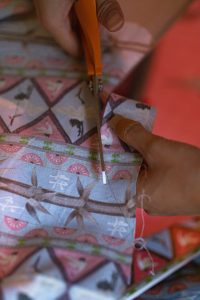37 Trimming and Grading
Sheri Deaton
Trimming and Grading
What is trimming?
Trimming is when you cut off part of the seam allowance to reduce bulkiness. This is often done on French Seams. See the “Magic Pillowcase Pattern” in Unit 10: Sample Projects of this textbook as an example of how to integrate this skill into the classroom.
Practice Makes Permanent
For extra practice on identifying measurements and sewing correct seam allowances, consider using the following steps to test your students’ abilities to accurately read a seam gauge, follow directions, sew at an appropriate seam allowance, and demonstrate the trimming technique (Deaton, 2021).
- On a scrap of fabric, sew a ⅝” seam lengthwise down the fabric.
- Backtack or backstitch at the beginning and the end of the seam to demonstrate appropriate sewing techniques.
- Using a seam gauge, straight edge ruler, and a fabric marker or chalk, mark the seam allowance to reflect a ⅜” seam allowance.
- Complete a peer review, meaning, switch fabric swatches with a classmate and have them evaluate your abilities to appropriately measure ⅜” while you evaluate their work.
- Receive and give feedback following the expectation that students are to build one another up and strengthen each other, never giving or receiving feedback from a critical lens.
- Adjust markings if needed. Otherwise, use scissors, shears, or a rotary cutter to trim the ⅝” seam allowance down to ⅜”.
- Allow the instructor to evaluate your work.
- Reflect on what you learned about the importance of creating a straight seam, using accurate measurements, and having the ability to trim fabric evenly and consistently.

What is grading?
Grading is when you trim each layer of the seam allowance to a different width. This is often done on flat felled seams. See the “Flat Felled Seams” chapter in Unit 7 Seams of this textbook for step-by-step processes on how to create a flat felled seam.
Let’s Grade
To assist students with understanding the difference between grading and trimming, consider using the following example procedures.
As students complete this experience, they will be demonstrating many skills, including their ability to accurately read a seam gauge, follow directions, sew at an appropriate seam allowance, and demonstrate the grading technique (Deaton, 2021).
- On a scrap of fabric, sew a ⅝” seam lengthwise down the fabric.
- Backtack or backstitch at the beginning and the end of the seam to demonstrate appropriate sewing techniques.
- Following ironing safety guidelines, adjust the iron to the setting that is appropriate for the fabric used in this project. Press the seam allowance open.
- Using a seam gauge, straight edge ruler, and a fabric marker or chalk, mark the upper seam allowance to reflect a ¼” seam allowance.
- Complete a peer review, meaning, switch fabric swatches with a classmate and have them evaluate your abilities to appropriately measure ¼” while you evaluate their work.
- Receive and give feedback following the expectation that students are to build one another up and strengthen each other, never giving or receiving feedback from a critical lens.
- Adjust markings if needed. Otherwise, use scissors, shears, or a rotary cutter to trim the upper seam allowance to a depth of ¼”. Only trim the upper seam allowance.
- Allow the instructor to evaluate your work.
- Reflect on what you learned about the importance of creating a straight seam, using accurate measurements, and your abilities to grade a seam allowance.

Hemming it Up
Grading and trimming both require students to read and follow directions, demonstrate proficiency in measuring, and safely and accurately use cutting equipment. Both techniques are used to reduce the bulkiness of seam allowances. When trimming is used, the seam allowances are both trimmed down to the same depth. When grading is employed, one seam allowance is cut at a different level than the other.
To help students remember the difference between trimming and grading you may consider using this analogy. We TRIM bushes to make them all the same height, but students earn different GRADES based on their performance. Word or phrase associations like this may be helpful for learners who are struggling to comprehend the difference between these two finishing techniques.

Resources
| Resources | QR Codes |
| How to Trim and Grade Seams |  |
| Trim and Grade Seam Allowances |  |
References
Deaton, S. (2021). Teaching Apparel Production. Presentation.

